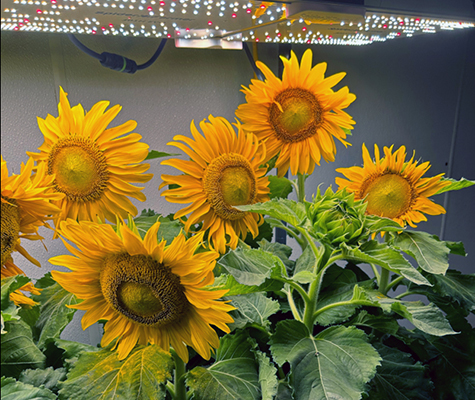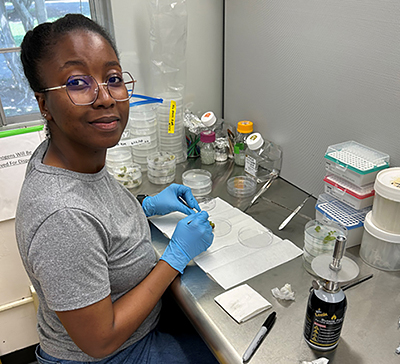
Protecting the Pollinators: New Flower Traits to Support Bee Health
 |
Vincent Ricigliano is a research entomologist at the Honey Bee Breeding, Genetics, and Physiology Research Unit in Baton Rouge, LA. He led one of three winning teams in the ARSX 2023 competition.
|
Welcome Dr. Ricigliano to Under the Microscope.
UM: What problem did you and your team set out to solve, and why was it a concern?
We were looking for new solutions to some of the challenges that pollinators are facing. Pollination is an essential ecosystem service that maintains biodiversity and is the foundation of agricultural crop production. Approximately one-third of the human food supply depends on pollinators. A majority of pollination is performed by bees, including widely managed honey bees and bumble bees as well as unmanaged wild bees.
In recent years, bee populations have been in significant decline due to a combination of factors such as habitat loss, pesticide exposure, and climate change. The spread of diseases and parasites, like the Varroa mite, has also severely impacted bee health and survival rates. This decline poses a critical threat to global food security, as bees play a vital role in pollinating many of the crops we rely on.
UM: Are there specific aspects of the challenges that pollinators are facing that you wanted to help address?
VR: The theme of ARSX2023 was “securing future food systems.” Our project aims to improve pollinator health as a way of safeguarding food security and ecosystem biodiversity. My project combines my current research focus on bee nutrition and pathogens with my background in plant biotechnology.
UM: How will your approach to pollinator health work?
VR: Coevolution between flowering plants and pollinators suggests that flowers are a promising way to deliver health-promoting molecules to bees. RNA is a messenger in cells that carries instructions to help make proteins, which are the building blocks of life. Interestingly, RNA and proteins from pollen can naturally influence bee development and gene expression. More broadly, plant RNA and proteins that animals obtain through their diets can influence the animals’ gene expression.
Our project attempts to harness this naturally occurring form of cross-kingdom interaction to improve bee health. We have selected a dwarf sunflower variety as the foundation for our prototype. Using modern biotechnological tools, we will introduce novel traits for delivery of beneficial biomolecules that can improve pathogen resistance and nutrition in bees that visit our flowers.
 Dwarf sunflowers being grown in the laboratory indoors under artificial lights. (Photo courtesy of Victor Rainey, USDA-ARS)
Dwarf sunflowers being grown in the laboratory indoors under artificial lights. (Photo courtesy of Victor Rainey, USDA-ARS)
UM: Have you done anything like this before? What led you to your approach?
VR: Our team won the ARSX2020 competition for a project involving engineered microalgae as a source of edible vaccines for bees. Our ARSX2023 project takes a similar approach, except we are using flowers as an interface to deliver health-promoting molecules to bees. Importantly, these projects are using modern biotechnology to develop sustainable solutions for pollinator health that do not rely on synthetic chemicals.
UM: What are the main goals for your project, in terms of pollinator health?
VR: Pathogens and malnutrition are key factors underlying pollinator declines. The main goal for our project is to test the hypothesis that flower traits can be engineered to specifically address these key stressors. If successful, it would open up an entire new area of research dedicated to producing plant varieties that are tailored to address pollinator health and nutrition.
UM: How does this project fit in the bigger picture of solving challenges that the agriculture sector faces?
VR: Our future food supply faces challenges like climate change, which affects crop yields, livestock, and pollinators. Increasing global population means higher demand for food, putting pressure on agricultural systems. Water scarcity and soil degradation reduce the land available for farming. Additionally, pests and diseases can threaten crops and livestock. All of these things require sustainable solutions to ensure food security.
If our project is successful, it could be part of an approach to addressing some of these challenges, through modification of plants to better support ecosystems and crops. The traits that we’re developing could potentially be expanded into other flowering plants, including crops. Right now, 50% of all U.S. cropland is dedicated to the production of GMO crops; we think the kinds of modifications that we’re developing could be a significant enhancement of what this technology can offer.
 Generating new sunflower varieties in the laboratory using plant tissue culture techniques.Sunflower plantlets growing on growth media containing different plant hormones. (Photo courtesy of Vincent Ricigliano, USDA-ARS)
Generating new sunflower varieties in the laboratory using plant tissue culture techniques.Sunflower plantlets growing on growth media containing different plant hormones. (Photo courtesy of Vincent Ricigliano, USDA-ARS)
UM: How does this kind of approach compare with the genetic modification that occurs in nature through evolution and natural selection?
VR: Genetically modified organisms (GMOs) are a touchy subject, largely due to misinformation about their safety and usefulness. Major scientific organizations like the World Health Organization, American Medical Association, and the National Academy of Sciences, collectively agree that GMOs are safe. GMOs can ensure food security by enabling us to develop crops that are resistant to pests, diseases, and extreme weather conditions, thereby increasing yields even in challenging climates. They can be engineered to require less water and to grow in poor soil conditions, making them more resilient to the impacts of climate change. Importantly, GMOs can reduce the need for chemical pesticides and fertilizers, promoting more sustainable farming practices. By enhancing the nutritional content of crops, GMOs can also address malnutrition and improve overall food quality.
Our project is inspired by the idea that biotechnology will ultimately transform agriculture, resulting in a second “Green Revolution.” Future crops will be fine-tuned for agronomic traits (i.e., yield, quality, water use). It is only logical to incorporate traits that will directly benefit pollinators, and for ARS to be at the forefront of this innovation.
UM: What have you found so far, and what lies ahead?
VR: We have selected a dwarf sunflower variety for our prototype. It has high pollen yields and is amenable to laboratory incubator growth due to its short stature. These attributes make it feasible to test our hypothesis that flowers can be engineered to improve pollinator health in a contained setting.
Within one year, we expect to conduct our first tests in a greenhouse to assess the ability of prototype flowers to improve bee resistance and nutrition. Ultimately, we expect to develop and patent new sunflower cultivars that can deliver beneficial molecules to bees and that have increased nectar content and pollen with increased protein and lipid content. In theory, these traits could be adapted for a broad variety of flowering plants and crops.
 Laboratory science technician, Daniela Adjaye establishing new plant cultures in the laminar flood dedicated to sterile work. (Photo courtesy of Vincent Ricigliano, USDA-ARS)
Laboratory science technician, Daniela Adjaye establishing new plant cultures in the laminar flood dedicated to sterile work. (Photo courtesy of Vincent Ricigliano, USDA-ARS)
UM: Have there been any challenges in the course of the project, and if so, how have you addressed them?
VR: The process that we use to generate new sunflower varieties is called plant tissue culture. While this method has been used in other labs for a long time, the specific protocols are highly dependent on the genetic makeup of the plants. This required us to develop our own protocols, which has taken a lot of time and attention to detail.
UM: What are you most excited about in this project?
VR: If successful, this project will provide a proof-of- concept for “pollinator health traits” that can be incorporated into future engineered crops. Future cropping systems and agricultural landscapes that incorporate the traits could provide vast acreages of flowers that are custom tailored for bee health.
UM: What can members of the public do in their own lives to help address the problems that pollinators face?
VR: People can grow pollinator-friendly plants in their gardens. For a bee-friendly garden, plant a diverse mix of native wildflowers, herbaceous perennials, and annuals. This mix will provide consistent blooms and nutrition for bees.
